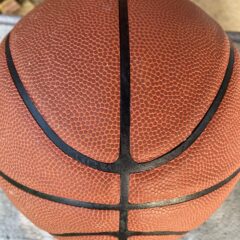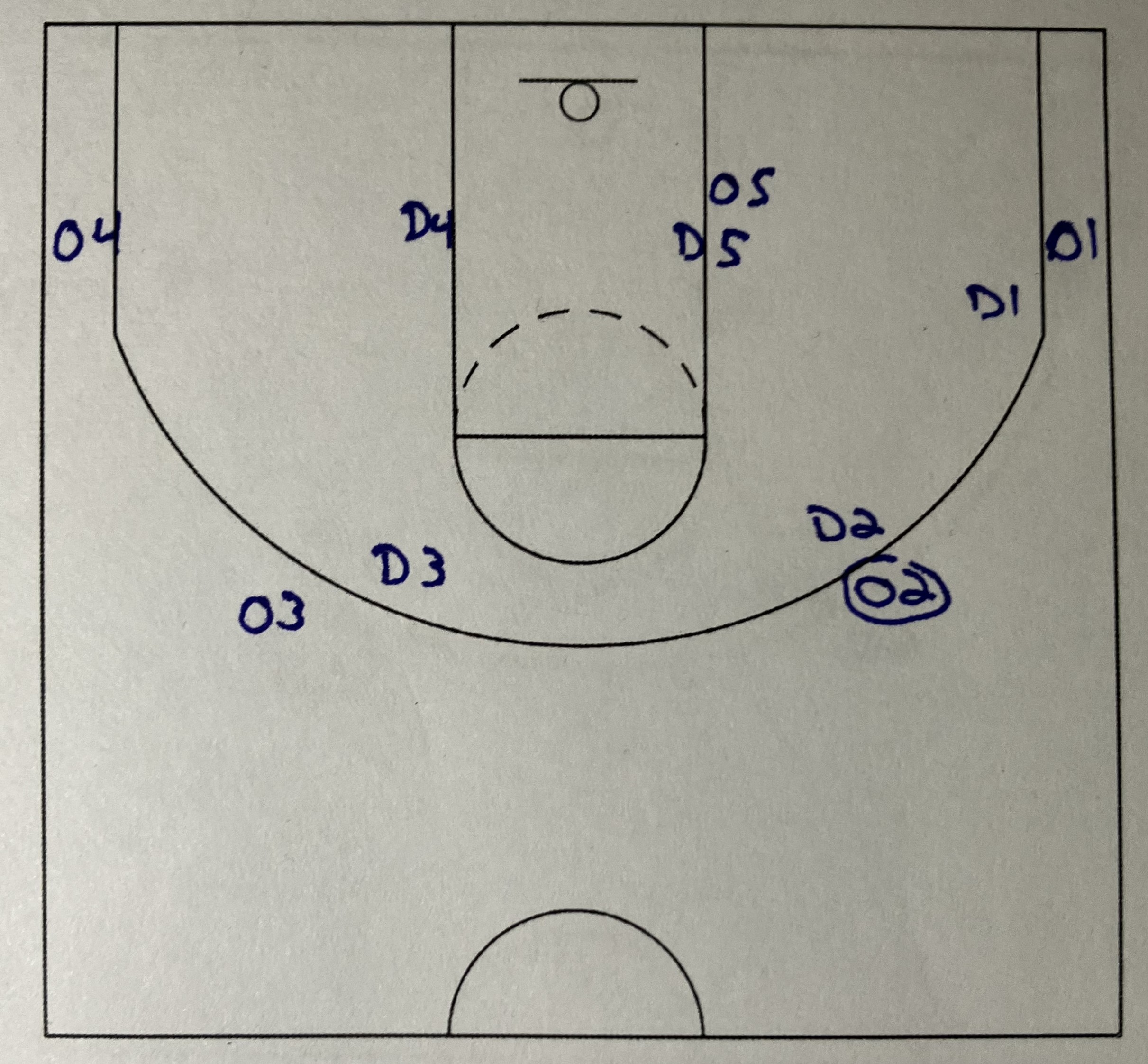The shell drill is one of the classic basketball drills. It helps to teach defensive positioning. It helps puts players into the right spots defensively as the ball is passed among the offensive players.
This is a great drill for beginning players or young players to use as they are learning the game of basketball. It gives them a chance to learn where to be positioned as the ball is moving around the floor is a very controlled drill.
I would run this drill at the beginning of the year as a JV coach every season. At first, the offense would hold the ball for 3 seconds. This allowed me to stop the drill at any time to move players into the correct spots. As the players would get better at getting to their spots, I would reduce the time from 3 seconds to 2 seconds. This meant the players had to move quicker. As we continued to do the drill with stopping and repositioning, the players would get to their spots faster. Finally, I would reduce the holding time down to 1 second.
The offense was restricted at first to only making passes to one of the other offensive players right next to them. Again, after the defensive players understood correct positioning, then the offense would be allowed to throw skip passes. Once the time was reduced down to 1 second and skip passes were being made, the defense learned how to move in and out of their spots. This made our half-court defense much better.
I would normally run the shell drill with only 4 players although a 5th player could be added in the post. The outside 4 players will stay the same no matter if there are 4 or 5 offensive players. The post defender will have their own rules depending on each team’s defensive philosophy on guarding the post. I like the post defender playing ½ to ¾ front on the post. This decision is made with the offensive player’s skill level and the defender’s ability to guard in the post in mind. Some teams will front the post which I have including in the diagrams.
The other big difference between 4 and 5 players is when the ball is entered into the post. Again, the work being done will be dependent on the defensive philosophy of the team. Some teams do not double the post. While others always double from the passer. Some teams may send a certain defensive player to always double and some may send the backside slot defender no matter which player is in that spot. I will break this down farther as I discuss the different positioning within the shell drill.
O1 has the ball

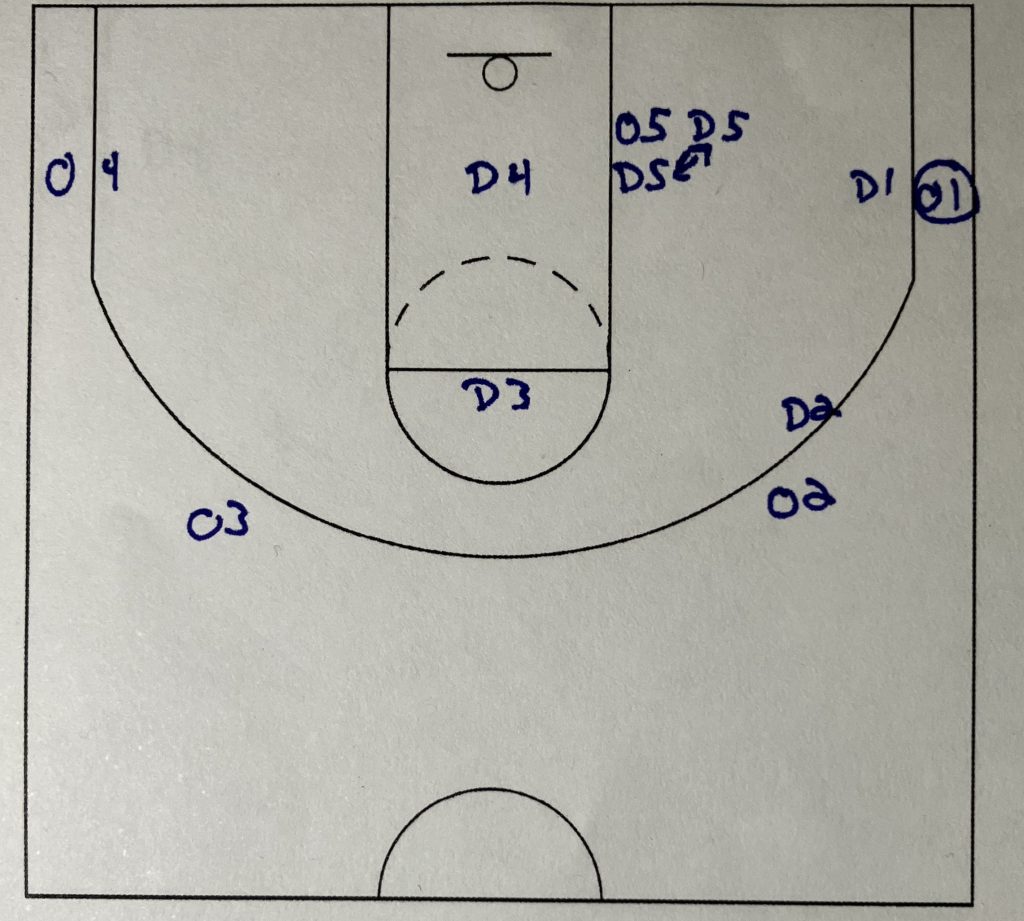
D1 is guarding the ball. D2 is playing one pass away. D3 and D4 is in help side position right at the midline of the court. Depending on the team’s philosophy, D5 could be completely fronting the post here. They could be ½ or ¾ front. They could be playing straight behind.
The decision on where to have D5 be is going to depend on how good of a post defender they are and how good of a post player O5 is. If O5 is somebody who can score at will in the post, then it might be better to front the post and try to prevent a pass. If O5 is not a scoring threat, then it might be better to stay straight behind and allow O5 to catch a pass because you do not fear them on the catch.
When the drill has just the four players, then D1 is on the ball defense. D2 is one pass away playing defense. D3 and D4 are on midline playing help side defense. By removing the post players, the defensive positioning of the four outside defenders becomes much easier to see and correct. If D3 and D4 are not on midline, then the openness of the lane becomes much more apparent. This is why I will run shell drill using only 4 players at times.
O2 has the ball

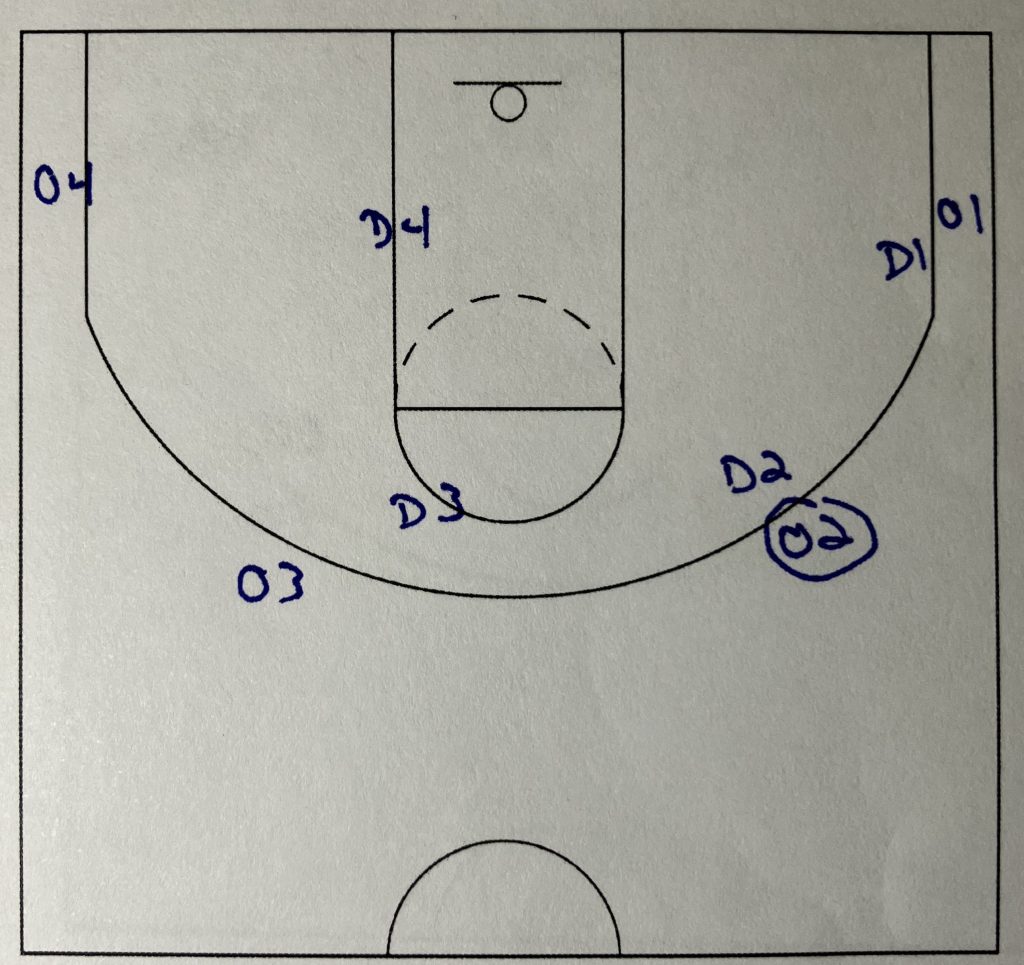
D2 is guarding the ball. D1 and D3 are playing one pass away. D4 should be positioned somewhere around the lane line to the midline. Some teams want to get to midline to prevent the drive. Some teams want D4 to be on the lane line to prevent the possible skip pass 3-point shot. I would say teach one way and be comfortable in what you are teaching as a coach.
I tend to overplay help side to prevent drives and layups. However, if O4 is a shooter, then the defender will stay closer to them. I think it is easier for a defender to reduce distant in a game rather then increase so I want them closer to midline as a rule. They can adjust back out if needed.
D5 can again be positioned in three spots. They can front the post. They can ½ or ¾ the post. Or they can play behind. The coach can decide how to play the post and teach the positioning they want.
The shell drill using only 4 players has D2 on the ball. D1 and D3 are both one pass away. D4 is somewhere from midline to the lane line. D4 will adjust depending on the offense players at D2 and D4. If O4 is a good shooter, then D4 will be on the lane line to be closer on the closeout on the skip pass to prevent the 3-point shot by O4. If O2 is a good driver, then D4 will be on midline to help on any drive.
O3 has the ball


D3 is guarding the ball. D4 and D2 are one pass away. D1 is in the same spot as D4 was in the previous diagrams. They can be midline out to lane line depending on philosophy of the defense. D5 is going to be off the of O5 somewhere around or just across the midline.
The placement of D5 is really about how far do you want them off of O5 and still be able to get back and box out on a shot. If they cannot get back to a good box out, then they are too far off of O5. A coach can have O3 shoot the ball and see where is a good spot for D5 to be positioned for the backside rebound.
With just 4 players, the roles are the same as when O2 has the ball just reversed. D3 is on the ball. D2 and D4 are one pass away. And D1 is playing somewhere between midline and lane line. D1 positioning will adjust out to the lane line with a good shooter at O1. D1 will be on midline with a good driver having the ball at O3.
O4 has the ball

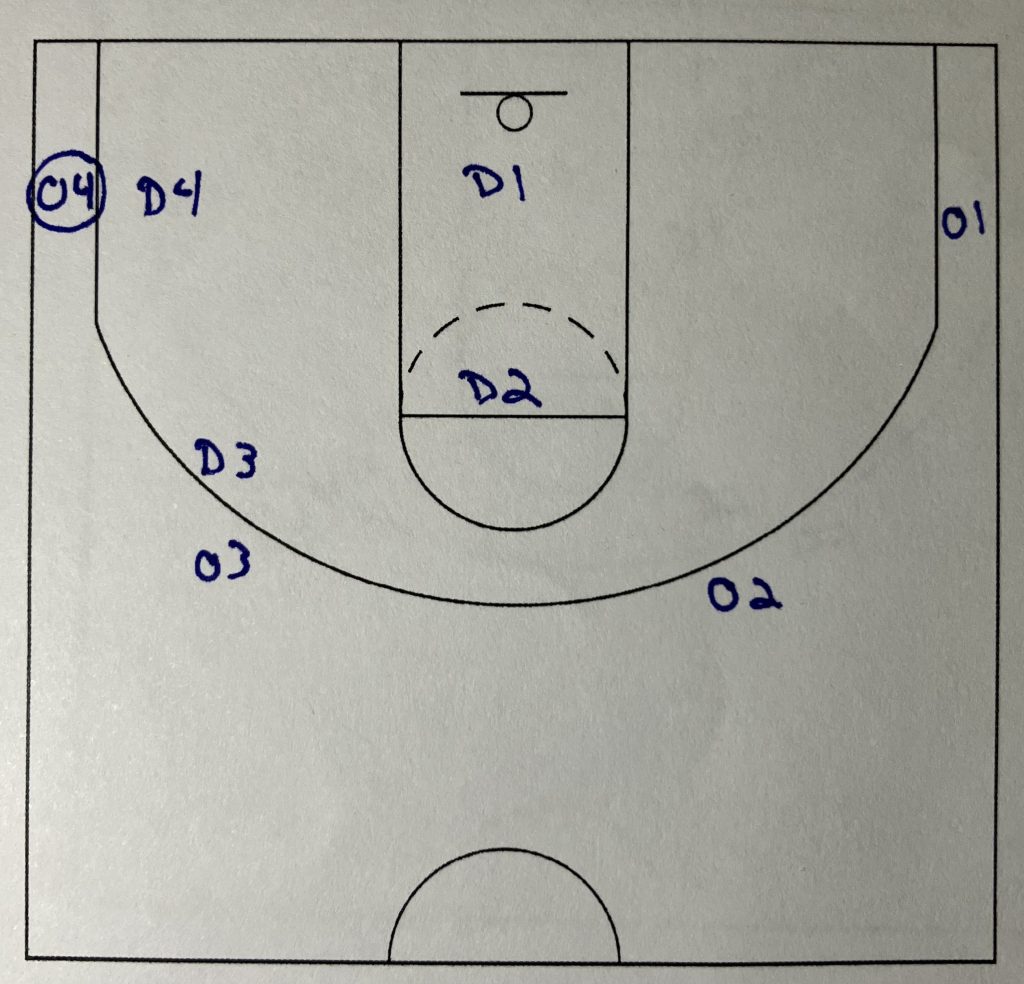
D4 is guarding the ball. D3 is one pass away. D2, D1 and D5 are all in help side position on the midline. This should look almost like a straight line. I will have D5 over the midline to help on any drives to the basket. By being over the midline D5 has a better chance to help outside the lane to make a potential drive and layup a much harder shot. If D5 is not far enough over midline, then a drive by O4 can lead to a layup even if D5 helps because the help will be too close to the basket to be effective.
The 3 players on the midline will be working on rotational defense with any drive. D5 is the help, D1 drops into O5 and D2 has the closeout on any pass to O2 or O1. On the kickout pass, D1 takes the offensive player who did not get the pass. This type of rotational defense can be introduced here in the shell drill.
On the 4-man shell drill, D4 will be playing on the ball defense. D3 will be in one pass away defense. D1 and D2 are on midline playing help side defense. D1 and D2 are ready to rotate on the drive. D1 and D2 are going to be working in tandem on the drive to be able to help on the drive while still working together to prevent any open shots by O1 and O2.
O5 has the ball
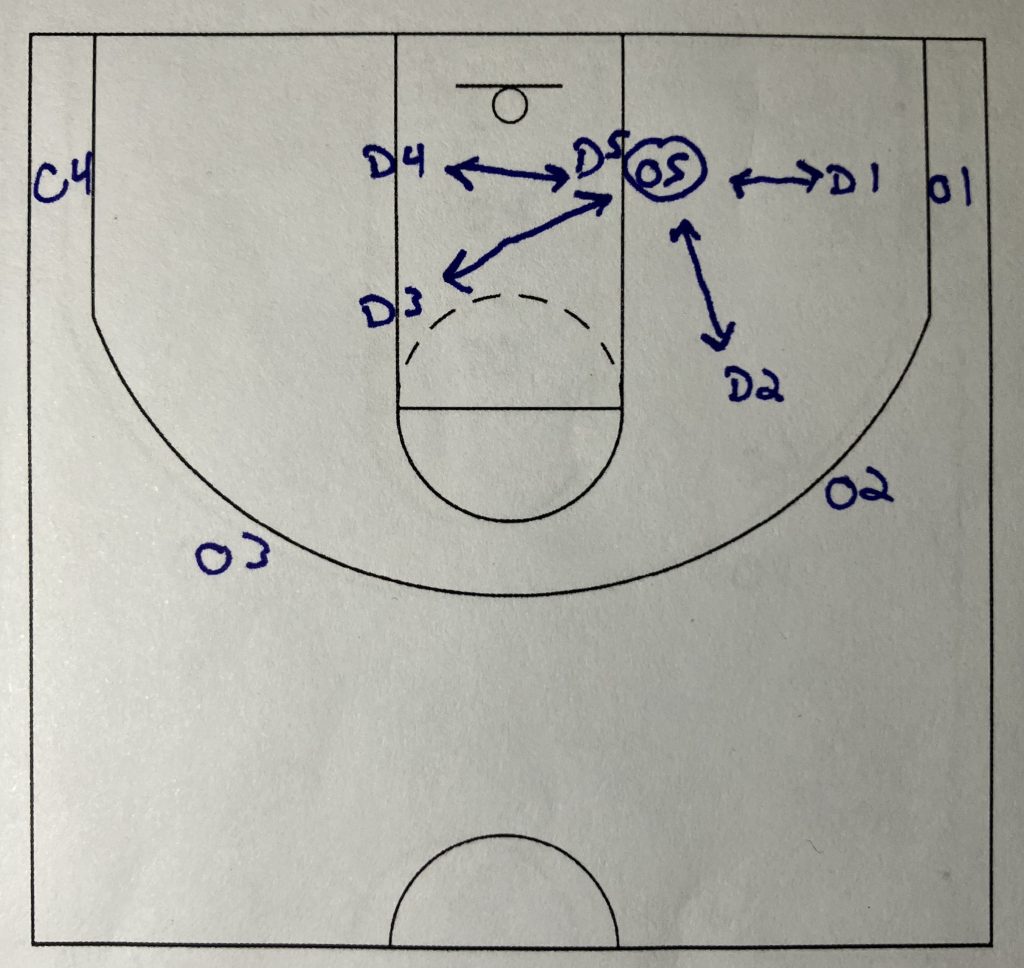
This is where a coach has to make decisions on their defensive philosophy so the drill can simulate a game as much as possible. The main philosophical questions are…
Do We Double the Post?
Who Doubles the Post?
For me, this is a game-by-game decision. If the offensive post player is not very good, then we do not double. If our defensive post player is really good, then we do not double the post. This changes if the post defender is in foul trouble.
If the offensive post player is good or our post defender is bad, then we double the post. The way that I like to double is by sending the defender whose offensive matchup is the worst offensive player on the other team. I have a defender who always goes to double no matter where they are at on the floor. I am willing to give the worst offensive player an open shot to prevent a post player from scoring.
However, some coaches like to send the ball side corner to always double. Some coaches send the backside slot defender, in the diagram D3, to always double. By sending the backside defender, the post player might not see them.
Also, the rotation up by D4 on the kick out is the easiest rotation back to O3. This means D3 will recover out to O4 on the kick out pass to O3 because of D4 rotating up.
Some coaches will double on the post catch. Some teams only go and double on the post dribble. Little changes by the defense can help to frustrate an opposing post player. And some coaches do not double but only have perimeter players prod into the post. They play halfway between the post and their perimeter man and will reach in and try to knock the ball loose. Halfway players are partially doubling but are also close enough to their man to close back out on the kick out pass.
So, there are plenty of options on how to guard the post but with each case there are some negatives with the positives. I will explain the positives and negatives for each player to double the post.
D1 Doubles
The positive is D1 is going to be the closest defender to the post so the double can get there quicker.
The negative is the corner kick out 3. D2 will not be able to rotate down to prevent the shot on the kick out. So, O1 is going to have a wide open shot every time on the kick out.
D2 doubles
The positive is D2 has the best angle on the double to make it hard for the offensive post player. The ball is likely to be held in a position for D2 to knock it loose. D2 is also coming down at an angle where the post player really can only go towards the baseline to score.
The negative is the post player should see the double coming. There is no way to surprise them. O2 can relocate for a kick out 3. Or O2 can cut to the backside block for a pass and layup. D3 or D4 has to help on the cut and if they don’t then the offense can have a lot of easy layups.
D3 doubles
The positives are the surprise factor and easiest rotation to recover for the defense. By bringing D3 from the backside, the post player might not see them coming until it is too late. Also, this is the easiest spot for the defense to recover and prevent the kick out open 3 because D4 can rotate up to O3 with D3 rotating out to O4 on the kick out pass.
The negative is the double might be too slow. A baseline move by the post makes the double completely useless. A quick middle move by the post player could be finished by the time D3 gets there to double.
D4 doubles
This is the biggest risk reward double. The reward is a steal on the positive side. This double makes it very hard for the post player to see coming until it is too late.
The risk is if the post player sees it and O4 cuts to the basket then it is an easy pass for a layup. When D4 doubles in this position it is normally going to be either a steal for the defense or 2 points for the offense.
Conclusion
The shell drill is a great drill for early season work. It helps players understand defensive positioning and how to move within the defense. Once those basic concepts are learned then the stationary shell drill should be removed from practice. In its place should be drills where the players are moving and not just standing. There are other drills, some are already on the site and some will be added that takes the shell drill and elevates it to a much better drill for players to continue to learn and grow.
